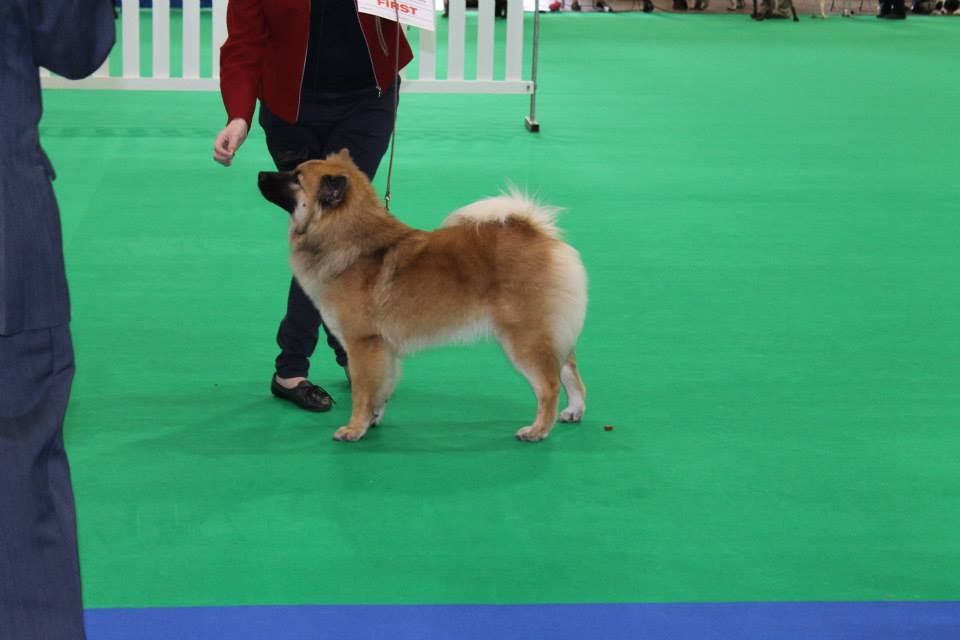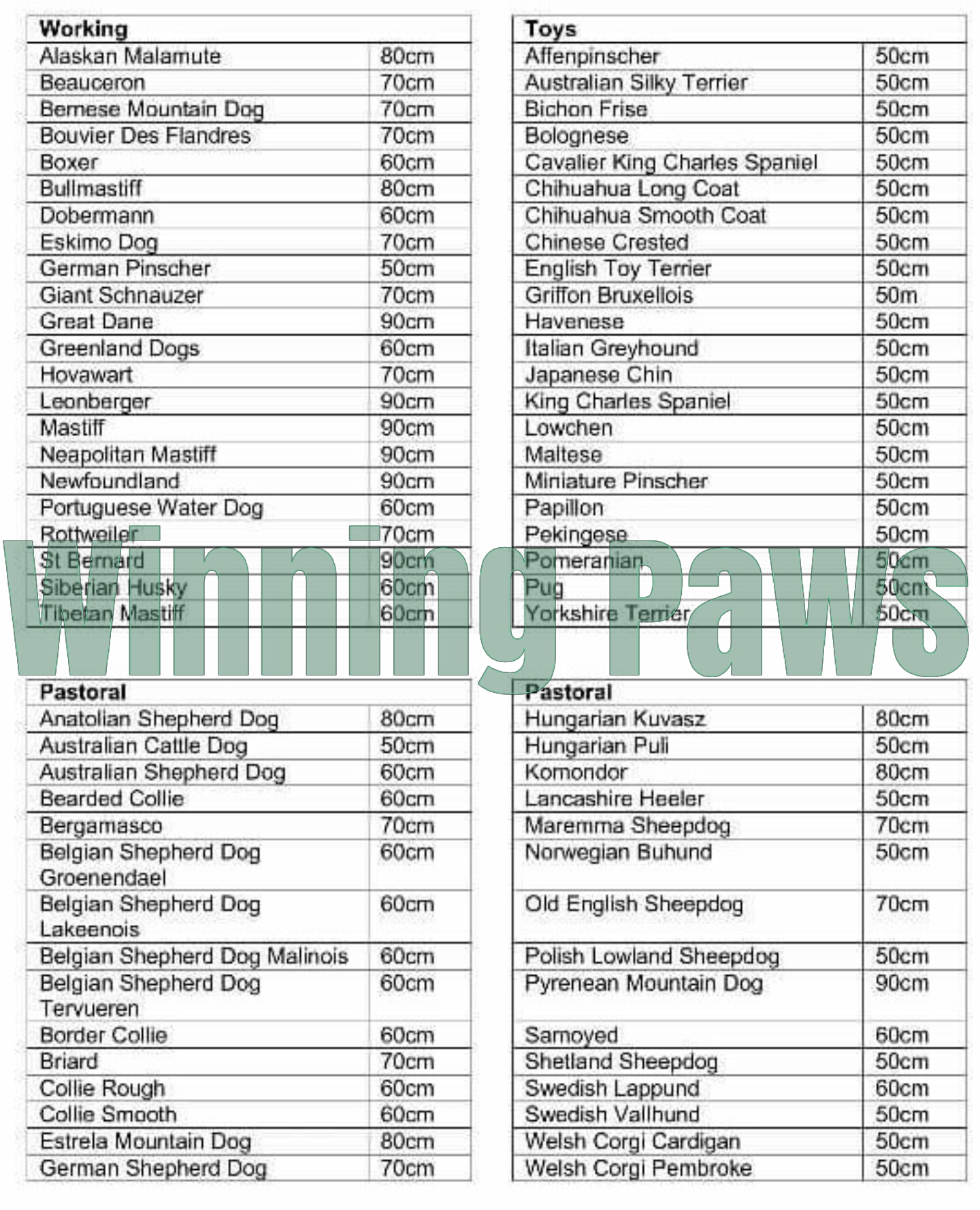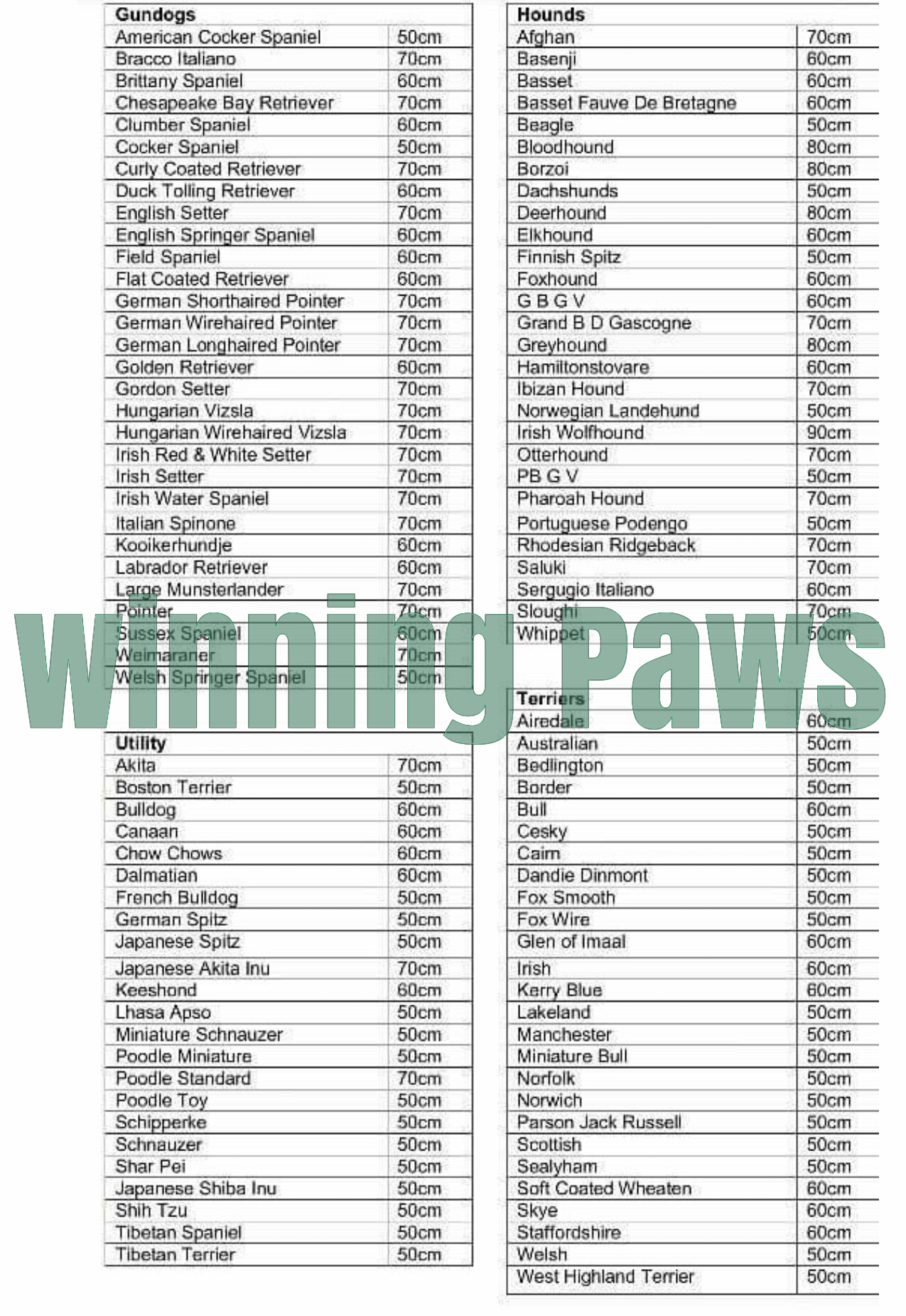I am in the progress of re-vamping and updating the blog. Four years of neglect and so I will go through the posts with out of date information, and re-share those that I hope will be useful.
Bench sizes
At championship shows where you have benches for the dogs, each breed has a minimum size. This is supposedly enough room for the dogs (I will let you decide!) And the benches for your breed should never be smaller than this.
If you get to a show and find they are smaller and you feel it’s too small, my advise would be to go a show official and speak to them about it to help resolve.
The below lists were found on the Kennel Club website back in 2012. But I doubt much had changed. I hope this is useful for deciding on cage sizes etc
Rules and Regulations of dog showing
Very often you will see people refer to the “Red Book” which is the bible of rules for all activities run by the Kennel Club in the UK. All shows must have the Red Book at the secretaries table, should you want to look up any rule at any point during a show. Good secretaries will often be familiar with the rules and any updates.
The sections are split alphabetically and the “f” regs are the show regulations.
Many exhibitors keep a copy of the rules on them while showing, either electronically or a printed copy. They can often be useful when discussing rules with other exhibitors. I have seen and heard so many times where people are given incorrect information on the rules and regulations. The only correct answer is written in black and white.
No-one can know all the rules – but it’s easy to look them up!
Not for Competition rules
Not for Competition rules at UK Kennel Club Breed shows
As of 2014
There has been much confusion in recent years of how old a puppy can be to enter Not for Competition at a UK Kennel Club Breed (conformation) show.
You can enter pups from 4 months NFC at single breed and sub group shows ONLY – all other shows (group and all breed) the NFC is from 6 months.
Some shows will allow spectator dogs and these can be of any age, there will often be a charge for this and you will need to see the secretary at the start of the show to fill a form in and pay (if the society are charging). This is open to spectators and not exhibitors technically
Rule F.1(c) states:
Only dogs of six calendar months of age and over on the first day of the Show are eligible for exhibition at Kennel Club licensed Shows.
However, societies may accept Not for Competition entries at their discretion. Dogs aged four calendar months and over are eligible to enter not for competition at Single Breed and Sub-Group Shows.
Furthermore, dogs aged four calendar months and over are eligible to enter Match competitions.
F(1) 11 states:
Animals Allowed in Show.
No animal other than an exhibit shall be brought into the precincts of a Dog Show during its continuance, except any dogs registered to assist the disabled, those brought for health testing (provided that the appropriate entry form declaration has been signed) or dogs required for educational or instructional purposes or by permission of the General Committee.However, at the discretion of the show society, a dog brought to the show by a spectator may be admitted into the precincts of the dog show, with the proviso that those in charge of the dog sign a declaration confirming the dog is free from disease and that the dog will be kept under proper control at all times. In the case of General and Group Championship Shows,the show society must apply to the General Committee for permission to admit spectators’ dogs as described above, and the granting of such permission will be entirely at the Committee’s discretion.
I hope this helps clear the NFC rule up for you.
Geraldine Hatch is new to showing and has kindly written about her advise for starting to show. I would like to thank her for writing about her experience of preparing to show your dog – from a newbies perspective.
Preparing to show – by Geraldine Hatch
When I got Frankie, my Eurasier, I promised the breeder I would show her. As well as being new to this breed I am quite new to showing, so have been on a huge learning curve the past 6 months.
I wanted to write this article for Winning Paws to share my experiences and help others who are new to showing. So, here are tips from me, from what I have learnt on this journey:-
Attend a ringcraft
This is a great place to socialise you dog, learn how to present your dog and yourself in the show ring and make lots of friends. I also found it a really useful place to ask questions about how to find shows and which classes to enter.
Get your entry in on time!
I didn’t realise before I started showing that the entries have to submitted so far in advance. There are a few different websites who do show entries. These can be quite confusing with all the different classes, so ask for help if you are not sure.
Check the order of judging
This is a great tip. Using whichever website you used to do your entry, you can check the order of judging and get an idea of what time you will be on. It will tell you which ring you are in, and how many breeds are in before you.
Check your journey in advance
I have found that a lot of show venues do not come up on my navigation device. Some are on farm grounds which may not have a postcode. My advice would be familiarising yourself with the route the night before and making sure it works.
Aim to arrive at the show early, this will make parking easier and also help you secure a place by your ring – lots are venues have limited space. Arriving early will also settle you and the dog, give you time to find and use the toilets and have a practice!
Grooming your dog
If you haven’t had the breed before, find out from your breeder the optimum time for doing your show preparation. I started off bathing the day before, but found this left my dog with a coat which was too soft and fluffy and not right the texture so I now do it 3 days before my which works much better.
What to wear
This really worried me. Luckily I was able to ask at ringcraft, but I have also lived and learned. Lots of people wear suits at champ shows. Open shows can be more casual while still looking smart and I normally wear trousers and a shirt or blazer. I would definitely suggest making sure you have comfortable shoes which you can easily move your dog in. I remember buying some shoes in the perfect shade of purple to match my suit – only to find they slipped off when I tried to trot!. I would also recommend wearing layers, shoes venues can be extremes of temperature, and you can never really tell until you get there. It is a good idea to look at what type of venue you are going to.
I once wore ballet style flats (it was the summer!) to an equestrian centre and spent the day with feet full of sand and wood chippings!
Find a companion
Dog shows can make for long days and boring car journeys. If you can find a friend to share the experience (and travel costs!) with it will be much more fun.
It is easy to make friends at ringcraft and find somebody who shows in the same group as you.
Have fun!
There was a long wait until my first show – Windsor champ show – when Frankie was 6 months and a few days old. After finding my bench and ring and doing a bit of practice (these can be other posts altogether!) we were on! All the build up and nerves and our time in the spotlight was over in a couple of minutes. It was so worth it though as we came away with a Crufts qualification as well as being hooked and hasn’t looked back since.
My biggest tip would be to enjoy it.

A round of applause
A round of applause
A group of people clapping (and cheering) can be off putting for dogs, especially while they are in the ring and you are asking your dog to stand still.
It is important to get your dog used to cheering, clapping etc that may go on ringside. Normally you can predict the huge cheers for your own ring (when the class is being placed or when a ticket is being handed out). However, you can’t predict for other rings around yours, and it could happen before your judge has made their decision, while your dog is bring gone over, or while your dog is moving.
If you attend ringcraft, ask them to make an applause, and regulary clap and cheer around your dog.
Desensitising your dog to this sound may help you in the ring one day!
Crufts 2014 – 111 days to go
Crufts is the worlds biggest dog show and is the pinnacle of shows held in the UK. It takes over halls 1-5 and the arena of the NEC Birmingham and uses all car parks!
To get to enter Crufts you have to qualify by gaining a 1st – 3rd place in selected classes at shows throughout the year, or some other awards at other shows thought out the year. Full details are on the Crufts website.
The event takes place over four days in March, normally over the second weekend of the month, Thursday to Sunday. This year it is the 6th-9th 2014. The groups are rotated which means that groups move days each year, so your breed will not always be on the same day every year.
Tens of thousands of dogs will be at Crufts for the conformation breed classes, all the other competition dogs (agility, flyball, obedience etc), service dogs, demonstration dogs and those manning the breed booths within discover dogs! Then you have all the trade stands selling everything you need for your dog.
The culmination of Crufts is Best In Show on the Sunday night. You will need to buy separate tickets to be admitted to the main ring on Sunday for the groups and Best in Show.
Only exhibiting dogs, or those invited by the Kennel Club are allowed to enter the show, so you cannot take any other dogs.
Puppies must be 8 months old by the first day of the show (6th March 2014) to be allowed to take part. Age classes are “specials” so read the definition of the class. For example, Special puppy is for puppies aged 8 to 14 months (rather then the normal 6 to 12 months).
For 2014, paper entries close on 6th January 2014 and online entries close online on the 20th January 2014. When you do your entries you will have a section which asks which show you qualified at, date/place so have that to hand. The catalogue you buy will apply to the groups scheduled for that day only.
Don’t forget, Crufts is a benched show like most general shows, so take your normal benching chain / cage. Benches are arranged in alphabetical order of the owners surname and your dog is allocated a numbered space. Your bench is generally right next to your ring.
Before the show, you can find out what hall you are in and it is worth looking at the layout before hand so you know which hall and car park you want.
At the show it can be very busy around the ringside with spectators so watch carefully and make your way to the ring entrance in time for your class.
On your bench you will find two numbers. One is your bench number and the other is the one you wear in the ring.
When you arrive, it is worth finding the dog exercise areas. There are a number a of indoor and outdoor exercise areas for you to use in each hall.
The car park will cost £10 for the day. For this lovely sum, you will get a long walking to the halls. South and East car parks have shuttle buses running all day to save you having to walk!
Due to dogs not being able to leave until 4pm, it is a very long day for dogs and humans. There is a mass exodus at 4pm as it takes a long time to clear the car park. It might be worth waiting for an hour or so and then leave.
Most of all, remember to enjoy your day and as always, you take the best dog(s) home!
Where can I train?
Where can I train?
This is a question with a simple, one worded answer…everywhere!
Training can be done anywhere and everywhere. Training must be kept fun, and part of this is keeping your training short, sweet and spontaneous.
Use you spare seconds in a day to do training and including a variety of rewards. Asking for a stand before letting your dog off the lead for a run, or going into a trot on a roadwalk incorporate training in time you are already spending with your dog. Also, asking for a free stand before you chuck the ball (again!) are great ways to incorporate training into your daily walks.
Getting a few seconds of training in during advert breaks of TV is another ideal time. Get in a few stands and lots of praise. Always end with treats or a game for your dog, and most of all, have fun.
“Good Boy”
“Good Boy”
Well ok, firstly to be politically correct I should say “boy or girl”!!!!!
When training your dog it is so important to praise for the behaviour that you want, so the dog is willing to offer that correct behaviour again, and again.
One of the fundamental mistakes I see in show training is wanting the dog to “stand still be gone over move in triangle and up & down then stand again then move to the end of the line” before they get any praise.
Please never do this until your dog can do all of the above perfectly!
You should break your training down to separate activities and only start putting them together once they are mastered. This will make sure you always praise for each behaviour.
Trust me, the results are quicker!!!!
When showing your dog in either breed classes and handling, two things you need to do at the same time are run in a straight line and watch the dog!
Some handlers are obsessed with looking at their dog the whole time, that they can’t run in a straight line and sometimes miss the ringtape!
Other handlers only look where they are going and do not check the dog and fail to see if their dog is or isn’t moving correctly.
The balance is to watch where you are running, with just a couple of glances to your dog. Try to keep it at a maximum of three glances per straight line!

